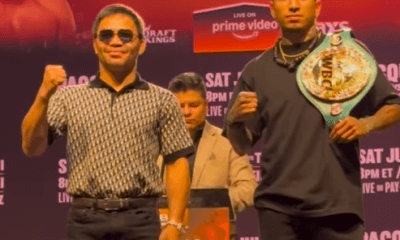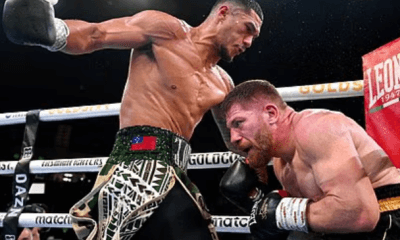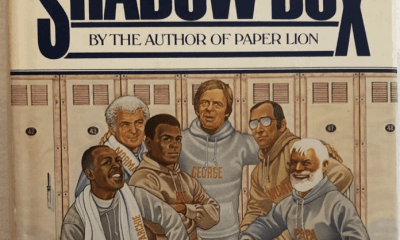Featured Articles
The Ring Proved a Refuge For Devon Alexander
For most people, the boxing ring might seem a dangerous place. The guy in the other corner is trying to hit you and, if he does it often enough and hard enough, he just might knock you out.
Every fighter knows what it’s like to walk on the wild side, and every fighter accepts pain as the price he must pay for doing what he does, whether he does it well or not. But there are areas far more foreboding than a roped-off swatch of canvas, and greater risks to take than swapping punches with a gloved opponent with a flashy record and putaway power. There are, after all, rules to be observed in boxing and a referee to enforce them.
For a lot of highly accomplished fighters, the streets where they grew up were tougher to survive than anything their blood sport could throw at them. In the harsher precincts of certain cities, kids must cope with the everyday reality of gangs, drugs, guns, poverty and despair. Some are fortunate enough to rise above their circumstances; many do not. Those who give up fall victim to an early death, or addiction, or long periods of incarceration. When that happens, they surrender the opportunity to achieve something better and become, well, statistics.
For IBF welterweight champion Devon Alexander (24-1, 13 KOs), who puts his title on the line against England’s Lee Purdy (20-3-1, 13 KOs) Saturday night in the Showtime-televised co-feature in Atlantic City’s Boardwalk Hall, the ring was a safe haven and the man who introduced him to boxing, former St. Louis cop Kevin Cunningham (seen on right, with Alexander, left, in above Hogan photo), a lifeline. Those few hours the 7-year-old Alexander spent in the gym every day with Cunningham, who remains his trainer, opened his eyes to the possibility that some dreams actually can come true for those with a strong enough will to succeed, and a strong enough vision to see beyond today.
“The bond I have with Kevin is unbreakable,” says Alexander, now 26, who admits that he is fighting for far more these days than purses and a bejeweled belt. “As I got older, I realized Kevin wasn’t just any boxing coach. He was a blessing to me, and my family.
“Before he started the gym (in the crime-infested Hyde Park section of St. Louis), I wasn’t doing anything and I wasn’t going anywhere. I had no sense of direction, no real purpose. I didn’t know what the future might hold; I wasn’t even thinking about the future then. Why would I? I was just a little kid. But kids not much older than me in my neighborhood were already living a rough lifestyle, a wrong lifestyle. Then again, when you’re that young, you really don’t have a sense of what’s right and wrong anyway. You grow up only knowing what you’re exposed to.
“Me being around Kevin made me realize my situation – my potential situation – wasn’t good at all. He taught me there was so much more out there than just St. Louis, or my particular part of St. Louis. He expanded my horizons. I came to understand just how special a person and how much of a friend Kevin was to me and kids like me. Who knows where I’d be now if it weren’t for Kevin? Would I be boxing? I really don’t know. I just know I’m thankful he came into my life.”
Lest anyone think that Cunningham routinely works such miracles, he is quick to point out that not everyone is as open to instruction or as fiercely determined to make good as Alexander. But when Alexander broke through to the top, he became a shining example to others of what could be, not necessarily of the vicious cycle that so many believe they are incapable of breaking.
“It’s huge,” Cunningham said of his prize pupil’s avoidance of the familiar traps into which so many Hyde Park kids fall into. “Any time you have a young man who comes from a disadvantaged background and can provide him with a positive outlet, that’s a good thing. It’s the kind of success story you always like to hear about. Me starting the boxing program, my goal was to help create more of those kind of success stories. It doesn’t always work out as well for everyone as it has for Devon, but I know that it can send a hopeful message.
“I’m glad I was able to help him, and he’s helped me as well. He’s a special person.”
More than a few big-time fighters have been where Alexander and Cunningham have been, and many of them speak of the benefits they have derived in winning their battles, large and small, in the ongoing war against the drudgery of a life on the street. But while words can be useful, actions that generate hope are even more so. Alexander and Cunningham put their time and money where their mouths are, and more importantly, where their hearts are. Maybe that’s because they know that, no matter how hard they try, they can’t save every at-risk child in Hyde Park, or places like Hyde Park.
Of the 30 original members of Cunningham’s boxing club, nine are now dead, and several others are behind bars. Nor has Alexander’s immediate family been spared the heartache of poor choices made. Devon, one of 13 children, first went to Cunningham’s gym as a tag-along with an older brother, Vaughn, who was 5-0, with four knockouts, as a promising junior middleweight. But Vaughn’s professional career came to an abrupt halt when he took part in an armed robbery, for which he was arrested and convicted. He is now serving an 18-year prison sentence, the fact of which is a constant reminder to Devon that more can and must be done. Oh, sure, he is a world champion again, but he wants to use that highly visible platform to become the sort of inspiring figure that Cunningham was to him.
“It’s my No. 1 priority,” Alexander said of the mantle of role-model he has so vigorously assumed. “I was in that environment. I lived and breathed it every day. It was all around me. I’m a witness to the drugs, the gangs, the violence, the killing … all of it. I’m a victim of that, or rather, I could have been a victim of that. Kids need to know there’s a different way, a better way. Kevin gave me a chance to see other possibilities.
“If you allow yourself to do it, you can become almost immune to what’s going on around you. It becomes so familiar you fall into, you know, a rut. I go into my old neighborhood now and see kids doing the same bad things the kids before them were doing. It’s sad. It’s hard to mentor kids, to get them to change those habits, but it can be done. Kevin showed me that, and I want to show kids who are where I was when he showed me. You have to get to kids early, and that’s what I want to do. That’s my mission. That’s my passion.”
It is Devon’s mission and passion outside the ropes that makes Cunningham realize that great things can be accomplished if the right seed is planted in the right mind. If you toss a pebble into a brook, do not the ripples expand? And so this team of chance, the now-grown-up kid and his longtime mentor, continue to spread the message that education and a healthy lifestyle, of both body and mind, represent the path to ultimate fulfillment.
“For Devon to rise up to what he has is a total blessing,” Cunningham said. “To go from where he was, a kid just starting out in the boxing program so he would have something positive to do after school and to stay off the street, and for that kid to advance to national tournaments and three world titles … it’s everything I ever could have hoped for. It’s even more than that. It’s like a little miracle.
“I’m so proud that Devon is a positive presence in the community. He speaks regularly at high schools, middle schools and even elementary schools in St. Louis, telling those kids they don’t have to fall into the traps of gangs and drugs and crime. He takes pride in being the right kind of role model for young people who come from the same places he came from. His message is that you don’t have to be a boxer or a football player or a basketball player to make it. Just stay focused, put the time in on your studies and you can be successful at whatever it is you choose to be.”
But for Alexander to maintain the platform from which he spreads those encouraging words, he realizes he must continue to win in the ring. And Purdy, a fill-in for another Englishman, the injured Kell Brook, isn’t disposed to make it easy for the man known as “Alexander the Great.”
“I’m a big puncher and if I catch him, it will be `game over,’” Purdy said.
There has been talk – quite a bit of talk, actually – that Alexander, provided he wins this fight, will be next in line for a megabucks unification showdown with WBC welterweight king Floyd Mayweather Jr., who is widely acknowledged as the best pound-for-pound fighter on the planet. But looking past your immediate opponent represents the same sort of pitfall that awaits the kids in Hyde Park every day. To make a poor choice is one thing; to make two is a pattern, and destructive patterns can be difficult to change.
Alexander insists he was “not mentally into” his only defeat as a pro, a points loss to Timothy Bradley in a 140-pound unification matchup on Jan. 29, 2011, and he said he will not make the same mistake again. “Money” Mayweather is not the guy he’s facing Saturday; Lee Purdy is. And that makes Lee Purdy the most important fight of Alexander’s career.
“When I was an amateur, I fought this guy who supposedly had no chance against me,” recalled Alexander, who posted a reported 300-10 record in the medals and trophies phase of his boxing development. “Everybody thought I’d get him out of there in the first round. In the first minute of the first round, probably. But he was a lot better than I expected. He gave me a hard fight. I was, like, `Man, I got told wrong about this dude.’
“That fight convinced me you can’t take anybody lightly. That man across the ring from you is there for a reason. He’s coming to win, and if you’re not as prepared as you need to be, he will win.”
As for a much-discussed shot at Mayweather, well, that is another topic for another day.
“I lot of people ask me about that,” Alexander said. “I just don’t like to talk about it. Everybody knows what could be. But you have to get past all the obstacles before you can even allow yourself to think about it. Yeah, it’s kind of hard not to think about it, but I use it for motivation. To get there, I have to do what I have to do against Lee Purdy. He’s a hungry fighter. He wants what I have. He wants my belt. I have to fight him as if I were fighting Floyd at that moment. I have to fight him as if I were fighting for my life. That’s the only way you can look at it.”
-

 Featured Articles3 weeks ago
Featured Articles3 weeks agoAvila Perspective, Chap. 330: Matchroom in New York plus the Latest on Canelo-Crawford
-

 Featured Articles2 weeks ago
Featured Articles2 weeks agoVito Mielnicki Jr Whitewashes Kamil Gardzielik Before the Home Folks in Newark
-

 Featured Articles4 weeks ago
Featured Articles4 weeks agoAvila Perspective, Chap 329: Pacquiao is Back, Fabio in England and More
-

 Featured Articles4 weeks ago
Featured Articles4 weeks agoOpetaia and Nakatani Crush Overmatched Foes, Capping Off a Wild Boxing Weekend
-

 Featured Articles3 weeks ago
Featured Articles3 weeks agoCatching Up with Clay Moyle Who Talks About His Massive Collection of Boxing Books
-

 Featured Articles4 weeks ago
Featured Articles4 weeks agoFabio Wardley Comes from Behind to KO Justis Huni
-

 Featured Articles1 week ago
Featured Articles1 week agoMore Medals for Hawaii’s Patricio Family at the USA Boxing Summer Festival
-

 Featured Articles4 weeks ago
Featured Articles4 weeks agoDelving into ‘Hoopla’ with Notes on Books by George Plimpton and Joyce Carol Oates
















